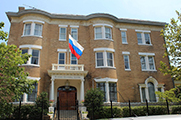|
The separate section of the exhibition taking place in the Russian Cultural Center is dedicated to the origin of the “Banner of Peace”
WASHINGTON, March 5. /Ivan Lebedev, TASS Correspondent/. On Friday evening the “Banner of Peace”, designed by Nicholas Roerich, met guests of the Russian Cultural Center in the capital of the USA. The exhibition dedicated to the 80th anniversary of signing of the Roerich Pact, the first international treaty on protection of the cultural heritage, was opened here.
Exposition prepared by the International Centre of the Roerichs (ICR) in Moscow has already travelled the whole world, and came to Washington fr om the UN Headquarters in New York. The exhibition was named “The Roerich Pact. History and Modernity”. It describes the development of the agreement which was intended to protect cultural values and first set the priority of this aim over military necessity.
“The main idea of Nicholas Roerich: peace through culture is reflected in this document, – First Deputy Director General of the ICR Pavel Zhuravikhin recalled while speaking at the opening ceremony. – More than 80 years have passed since signing of the Roerich Pact, but peacekeeping principles that it lays down are still important in the contemporary world. Nicholas Roerich was convinced that if we expand the area of culture we will narrow the area of war.”
Cultural cooperation continues
During the interview with TASS correspondent, Mr.Zhuravikhin said that exhibition in Washington would work until the end of March but now the negotiations are under way to continue displaying the exhibition in other cities of America and Canada. Earlier it toured 17 countries and nearly 200 cities wh ere over 500 thousand people attended it. The Head of Russian Cultural Center Oleg Zhiganov noted that this project demonstrates that “despite political disputes the cultural cooperation between Russia and USA is continuing.”
More than 200 exhibits including copies of archive documents, photos, reproductions of Nicholas Roerich’s paintings discover the life pages of this outstanding artist, writer, philosopher and public figure. Preservation and studying of his artistic heritage comprising popularization of ideas of the Roerich Pact that are still relevant nowadays, are among the primary aims of the International Centre of the Roerichs.
A series of photos depicted the massive destructions of historical and cultural monuments during the World War II, as well as armed conflicts on the territory of former Yugoslavia, Afghanistan, Iraq, and Syria. Evidence of barbarous destruction of unique cultural values by Afghan Taliban and terrorists from Islamic State of Iraq and the Levant (forbidden in Russia) was provided in the documental film created by the ICR employees. This work dedicated to the origin of the Pact also includes rare archive records of performances of Svetoslav Roerich, a younger son of Nicholas Roerich, who transferred a part of his father’s collection to Moscow.
The separate section of the exhibition launched in the Russian Cultural Center is devoted to the origin of the “Banner of Peace” – flag of the Pact with a red sphere with three circles on a white background. As stated by the author this flag could be “the symbol of the whole civilized world” and must be raised over all cultural objects needed to be protected.
Pact is a predecessor of contemporary conventions
Treaty on Protection of the artistic and scientific institutions and historic monuments initiated by Nicholas Roerich was signed on April 15, 1935 in Washington by the representatives of 21 American states. The solemn ceremony took place in the White House in presence of the USA President Franklin Roosevelt.
The Hague Convention for the Protection of Cultural Property in the Event of Armed Conflict was accepted on the basis of the Pact under the auspices of UNESCO in 1954. Many ideas of the distinguished artist and thinker who was born in St. Petersburg, left Russia in 1917 and passed away in India were used in development of other international documents, aimed at protecting cultural and natural heritage.
Source: TASS Russian News Agency, March 5, 2016
| 
